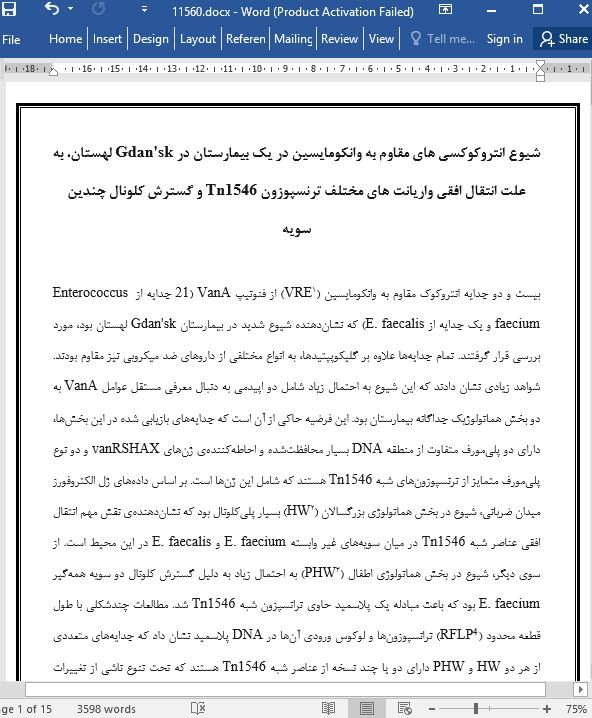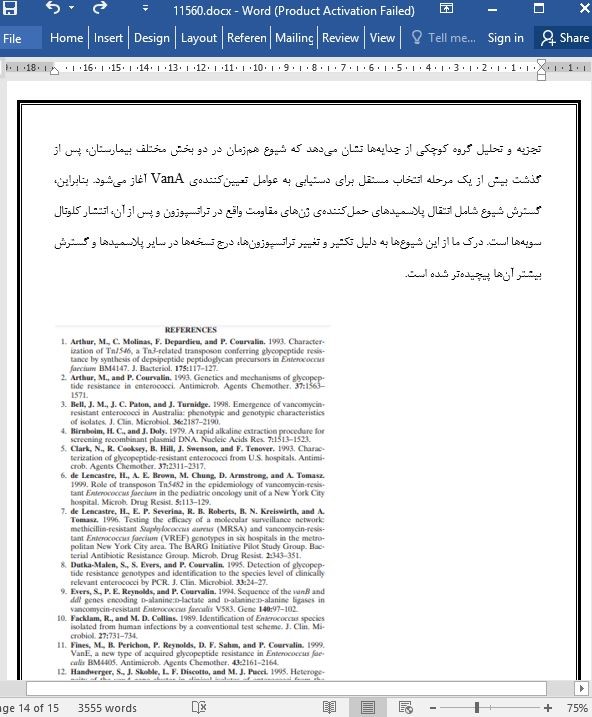
شیوع انتروکوکسی های مقاوم به وانکومایسین در یک بیمارستان در Gdan'sk لهستان
بیست و دو جدایه انتروکوک مقاوم به وانکومایسین ( VRE) از فنوتیپ VanA (21 جدایه از Enterococcus faecium و یک جدایه از E. faecalis) که نشان دهنده شیوع شدید در بیمارستان Gdan'sk لهستان بود، مورد بررسی قرار گرفتند. تمام جدايه ها علاوه بر گليکوپپتيدها، به انواع مختلفي از داروهاي ضد ميکروبي نيز مقاوم بودند. شواهد زیادی نشان دادند که این شیوع به احتمال زیاد شامل دو اپیدمی به دنبال معرفی مستقل عوامل VanA به دو بخش هماتولوژیک جداگانه بیمارستان بود. این فرضیه حاکی از آن است که جدایه های بازیابی شده در این بخش ها، دارای دو پلی مورف متفاوت از منطقه DNA بسیار محافظت شده و احاطه کننده ی ژن های vanRSHAX و دو نوع پلی مورف متمایز از ترنسپوزون های شبه Tn1546 هستند که شامل این ژن ها است. بر اساس داده های ژل الکتروفورز میدان ضربانی، شیوع در بخش هماتولوژی بزرگسالان ( HW) بسیار پلی كلونال بود كه نشان دهنده ی نقش مهم انتقال افقی عناصر شبه Tn1546 در میان سویه های غیر وابسته E. faecium و E. faecalis در این محیط است. از سوی دیگر، شیوع در بخش هماتولوژی اطفال ( PHW) به احتمال زیاد به دلیل گسترش کلونال دو سویه همه گیر E. faecium بود که باعث مبادله یک پلاسمید حاوی ترانسپزون شبه Tn1546 شد. مطالعات چندشکلی با طول قطعه محدود (RFLP ) ترانسپوزون ها و لوکوس ورودی آن ها در DNA پلاسمید نشان داد که جدایه های متعددی از هر دو HW و PHW دارای دو یا چند نسخه از عناصر شبه Tn1546 هستند که تحت تنوع ناشی از تغییرات مختلف ژنتیکی قرار گرفته اند. داده های گزارش شده، اپیدمیولوژی بسیار پیچیده اولین و تا کنون تنها شیوع VanA VRE را در لهستان نشان داده اند.
گزارش های متعددی در این زمینه، اکثر پدیده های اپیدمیولوژیک نشان داده شده در این مطالعه را تایید کرده اند. چندین حادثه انتخابی (33)، انتقال به رپلیکون های مختلف (1، 2، 6)، انتقال افقی توسط پلاسمید (34) و انتشار کلونال سویه های اپیدمیک (20، 29)، به عنوان عوامل اصلی گسترش مقاومت به وانکومایسین در جمعیت های انتروکوکسال هستند. با این حال، در اغلب موارد، موازی بودن وقوع همه این مکانیسم ها در مطالعات چند مرکزی (12، 23، 29) یا مطالعاتی که در آن ها جدایه های انسانی و غیر انسانی مورد مقایسه قرار گرفته بود، گزارش شد (31، 32). داده های ارائه شده در اینجا نشان دهنده پیچیدگی وضعیت اپیدمیولوژیکی در مورد VRE است که ممکن است در یک مرکز پزشکی رخ دهد. تجزیه و تحلیل گروه کوچکی از جدایه ها نشان می دهد که شیوع هم-زمان در دو بخش مختلف بیمارستان، پس از گذشت بیش از یک مرحله انتخاب مستقل برای دستیابی به عوامل تعیین کننده ی VanA آغاز می شود. بنابراین، گسترش شیوع شامل انتقال پلاسمیدهای حمل کننده ی ژن های مقاومت واقع در ترانسپوزون و پس از آن، انتشار کلونال سویه ها است. درک ما از این شیوع ها به دلیل تکثیر و تغییر ترانسپوزون ها، درج نسخه ها در سایر پلاسمیدها و گسترش بیشتر آن ها پیچیده تر شده است.
Twenty-two vancomycin-resistant enterococcal (VRE) isolates of the VanA phenotype (21 Enterococcus faecium isolates and 1 E. faecalis isolate), representative of a large outbreak that occurred in a hospital in Gdan´sk, Poland, were studied. All of the isolates demonstrated resistance to a wide variety of other antimicrobial agents in addition to glycopeptides. Several lines of evidence suggested that the outbreak most probably consisted of two epidemics that followed the independent introduction of VanA determinants into two separate hematological wards of the hospital. This hypothesis is supported by the fact that isolates recovered in these wards possessed two different polymorphs of the highly conserved DNA region encompassing the vanRSHAX genes and two distinct polymorph types of Tn1546-like transposons, which contain these genes. According to pulsedfield gel electrophoresis data, the outbreak in the adult hematology ward (HW) was highly polyclonal, which suggested a major role for the horizontal transmission of Tn1546-like elements among nonrelated strains of E. faecium and E. faecalis in this environment. On the other hand, the outbreak in the pediatric hematology ward (PHW) was most probably due to the clonal spread of two epidemic E. faecium strains, which had exchanged a plasmid carrying the Tn1546-like transposon. Restriction fragment length polymorphism studies of transposons and their insertion loci in plasmid DNA have suggested that numerous isolates from both HW and PHW contained two or more copies of Tn1546-like elements that underwent diversification due to various genetic modifications. The reported data demonstrated a very complex epidemiology of the first, and up to now the only, VanA VRE outbreak characterized in Poland.
Numerous previous reports have documented the majority of the epidemiological phenomena demonstrated by the present study. Multiple selection events (33), transposition to different replicons (1, 2, 6), plasmid-mediated horizontal transfer (34), and clonal dissemination of epidemic strains (20, 29) were revealed as major factors of vancomycin resistance spread in enterococcal populations. However, in most cases the parallel occurrence of all of these mechanisms was reported either in multicenter studies (12, 23, 29) or studies in which isolates of both human and nonhuman sources were compared (31, 32). Data presented here demonstrate the complexity of the epidemiological situation concerning VRE that may occur in a single medical center. Analysis of a small group of representative isolates has shown that concurrent outbreaks in two different wards of the hospital commenced following more than one independent selection event for acquisition of the VanA determinants. Thus, the developing outbreaks consisted of transmission of plasmids carrying the transposon-located resistance genes, followed by clonal dissemination of the strains. Our understanding of these outbreaks has been subsequently getting more complicated due to transposon multiplication and modification, insertion of copies to other plasmids, and their consequent further spread.
مواد و روش ها
نتایج
بحث
MATERIALS AND METHODS
RESULTS
DISCUSSION
- اصل مقاله انگلیسی با فرمت ورد (word) با قابلیت ویرایش
- ترجمه فارسی مقاله با فرمت ورد (word) با قابلیت ویرایش، بدون آرم سایت ای ترجمه
- ترجمه فارسی مقاله با فرمت pdf، بدون آرم سایت ای ترجمه



